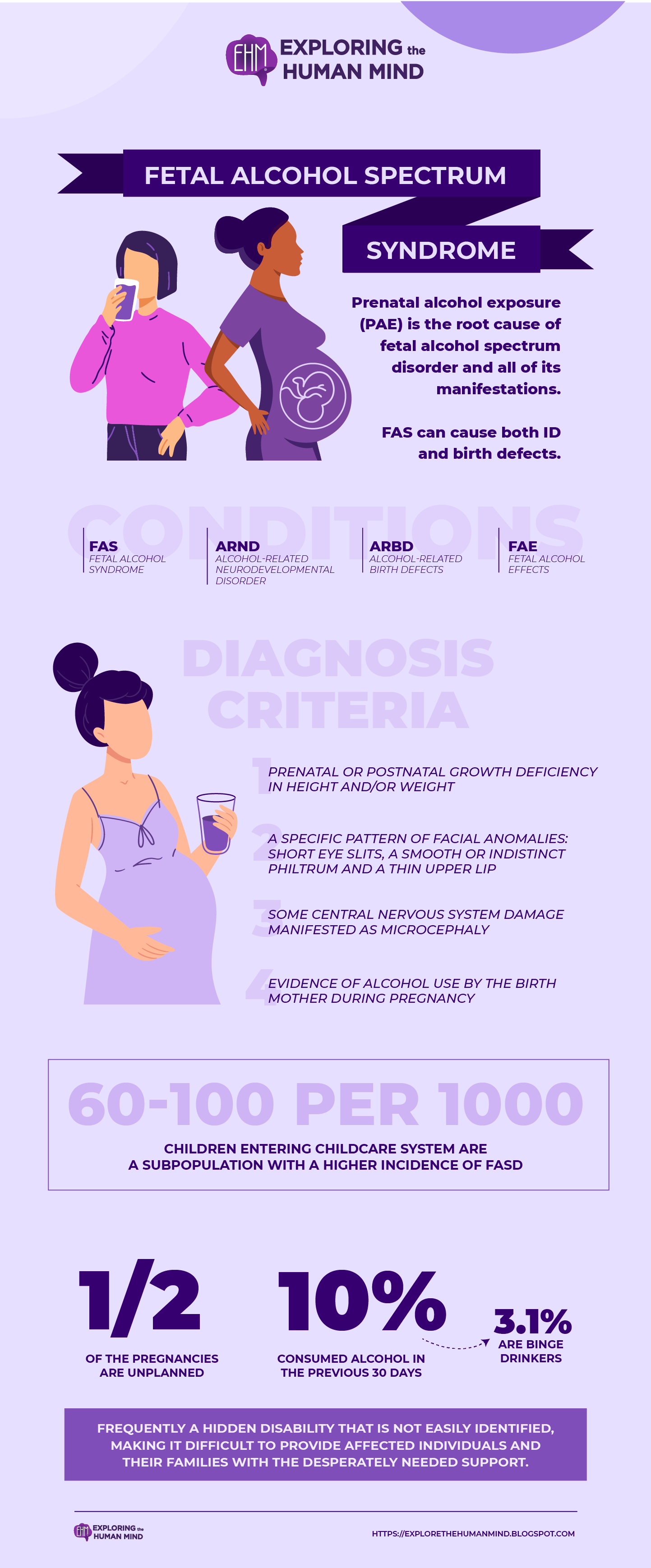Fetal Alcohol Spectrum Syndrome Introduction
FASD (Fetal Alcohol Spectrum Disorder) is an umbrella term that describes a variety of effects that can occur in a person whose mother drank alcohol while pregnant. Physical, behavioral, mental, and/or learning disabilities may result, in long-term consequences. It is recognized by abnormal facial features, central nervous system problems, and slow growth, and it occurs when pregnant women consume alcohol and pass it on to their unborn babies via the bloodstream. FASD can result in varying degrees of physical and mental disability (including intellectual disability). It is frequently a hidden disability that is not easily identified, making it difficult to provide affected individuals and their families with the desperately needed support.
FASD includes a number of conditions, including:
- FAS(Fetal Alcohol Syndrome)
- ARND(Alcohol-Related Neurodevelopmental Disorder)
- ARBD(Alcohol-Related Birth Defects)
- FAE(Fetal Alcohol Effects)
Diagnosis criteria
FASD is diagnosed by 4 criteria:
FASD includes a number of conditions, including:
1. Prenatal or postnatal growth deficiency in height and/or weight.
2. A specific pattern of facial anomalies: short eye slits, a smooth or indistinct philtrum (the vertical ridges running between the nose and lips), and a thin upper lip.
3. Some central nervous system damage manifested as microcephaly (small brain size), tremors, hyperactivity, fine or gross motor problems, attentional deficits, learning disabilities, intellectual impairments, and possible mental retardation.
4. Evidence of alcohol use by the birth mother during pregnancy (some diagnoses are made despite this criterion).

vectors by Freepick; graphic design by Vadot
Statistics
While PAE rates are frequently regarded as high, not every reported incident of alcohol exposure results in FASD. Children entering childcare systems, such as foster care and orphanages, are also a subpopulation with a higher incidence of FASD, with estimates ranging from 60 to 100 per 1000 children.
According to the most recent national data from the Centres for Disease Control and Prevention (CDC), alcohol consumption during pregnancy is not uncommon, with 10.2% of pregnant women reporting that they consumed alcohol in the previous 30 days and 3.1% reporting binge drinking. Furthermore, approximately half of the pregnancies are unplanned, and a woman may not realise she is pregnant until the sixth week of gestation or later, during which time she may still be drinking and causing harm. As a result, many pregnancies are alcohol-exposed, resulting in a population of children at risk for FASDs, particularly ND-PAE.
Recent studies involving active, expert clinical evaluation of school-aged children estimate that 2% to 5% of children in the United States have FASD. According to a review of medical records, the majority of these children have not been identified or diagnosed.
FASD is more common among certain Native American tribes and Alaska natives. It is also not uncommon for adoptive parents to learn that their adopted child has FASD. According to a recent survey of children with FASD evaluated at a paediatric clinic, 35% live in adoptive families.
Reference:
Aniruddho Chokroborty-Hoque, Alberry, B., & Singh, S. M. (2014). Exploring the Complexity of Intellectual Disability in Fetal Alcohol Spectrum Disorders. 2. https://doi.org/10.3389/fped.2014.00090
Fetal Alcohol Spectrum Disorder. (2023). Intellectualdisability.info. http://www.intellectualdisability.info/conditions-associated-with-intellectual-disability/articles/fetal-alcohol-spectrum-disorder
Fetal Alcohol Spectrum Disorder What Is Fetal Alcohol Spectrum Disorder (FASD)? (n.d.). https://thearc.org/wp-content/uploads/forchapters/FASD.pdf Hagan, J., Balachova, T., Bertrand, J., Chasnoff, I. J., Dang, E. P., Fernandez-Baca, D., Kable, J. A., Kosofsky, B. E., Senturias, Y., Singh, N., Sloane, M. A., Weitzman, C., & Zubler, J. (2016). Neurobehavioral Disorder Associated With Prenatal Alcohol Exposure. 138(4). https://doi.org/10.1542/peds.2015-1553






Comments
Post a Comment